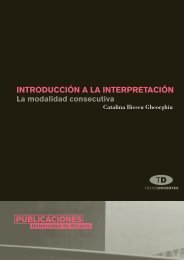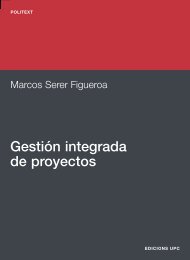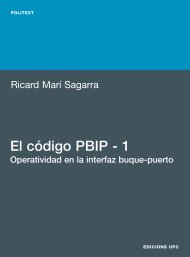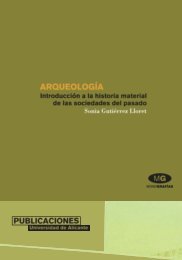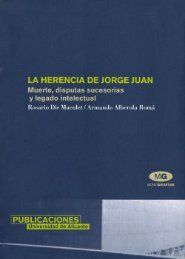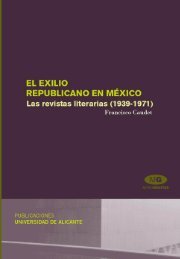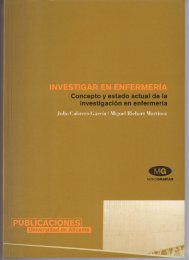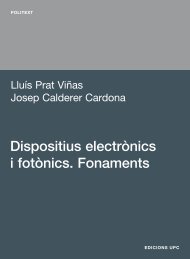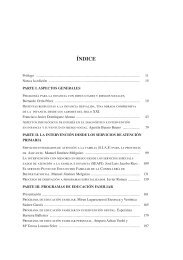Technical Writing - e-BUC
Technical Writing - e-BUC
Technical Writing - e-BUC
- No tags were found...
Create successful ePaper yourself
Turn your PDF publications into a flip-book with our unique Google optimized e-Paper software.
For our families
ContentsPart I. INTRODUCTION TO TECHNICAL WRITING 9<strong>Technical</strong> writing at university 11Chapter 1. What is technical writing? 131.1 Why is it important to study technical and professional communication? 141.2 Characteristics of technical writing 181.3 Functions of technical discourse 22Part II. THE WRITING PROCESS 31Introduction to the writing process 33Chapter 2. Pre-writing stage 372.1 Introduction 382.2 Analyzing audience 382.3 Analyzing purpose 512.4 Considering style and tone 562.5 Generating ideas 722.6 Outlining 78Chapter 3. <strong>Writing</strong> stage 853.1 Introduction 863.2 Drafting 863.3 Structuring the paragraph 873.4 Developing paragraph patterns 97© The Authors, 2007. © Edicions UPC, 2007
4CONTENTS3.5 Providing intra-paragraph coherence 1133.6 Structuring the essay 1303.7 Developing essay patterns 1473.8 Providing inter-paragraph coherence 1513.9 Incorporating visual aids 163Chapter 4. Post-writing stage 1794.1 Introduction 1804.2 Revising content and organization 1804.3 Checking for grammatical accuracy 1834.4 Editing for style 2034.5 Proofreading and peer review 2204.6 Academic and sample texts 224PART III. HANDBOOK 233Introduction to the handbook 235Chapter 5. Grammar, Style and Punctuation 2375.1 Introduction 2385.2. Main constituents in language: the phrase, the clause and the sentence 2385.3 Revision of intra- and inter- coherence 2445.4 Revision of grammar and style 2565.5 Punctuation 263APPENDIX 277Key to the exercises 279© The Authors, 2007. © Edicions UPC, 2007
Preface1. Purpose and approachThis book arose from the need to have a textbook to teach technical writing to Spanishengineering students at university. Although there are good books on technical writing aswell as on writing in general on the market, we could not find one that suited our students’needs: they were either too theoretical, too practical or simply aimed at students with adifferent cultural background. Because of this, we decided to write a book that kept thebalance between the theoretical explanations necessary to understand the basic concepts onwhich technical writing is based and the practical aspects that would enable students to putinto practice these theoretical concepts. After all, writing is a communication skill that ismostly learnt and mastered by practising it; it is not enough to have a good command ofgrammar and punctuation. <strong>Writing</strong> is a much more complex task requiring other techniques,such as organizing ideas logically and clearly, joining sentences coherently, using theappropriate tone and style, etc. Mastering writing, as any experienced writer knows, takestime and practice and a good way to improve writing that cannot be overlooked is reading.The more you read, the better you will write since reading is a practice that rubs off byimproving vocabulary, grammar and writing techniques in general. Thus, students areencouraged to read as much as possible and from almost any kind of reading—magazines,fiction books, newspapers, novels, Internet articles, etc. Although the kinds of documentstechnical students will be asked to write may not require the same level of subtlety as forexample a novel, they still call for some of the same skills.The book’s approach to writing is integrative and results from drawing on knowledge ofthree different approaches—product, process and genre. The process approach is the centralone to which the other two are subsumed. We took the process approach as the core orcentral one because we believe it highly contributes to the development of students’ writingabilities as it gives much importance to the skills or stages involved in writing. In a word,untrained writers, like most of our students, welcome having some sort of guidance to helpthem get started and organize their ideas, and this approach has proved to serve this purpose.We should emphasize that this approach is by no means prescriptive but acts more as© The Authors, 2007. © Edicions UPC, 2007
8PREFACEBoth the flexibility of the tasks and the methodology described above enable this book to beused within the incoming European Educational System as it caters for students’ individualneeds and learning styles and promotes collaborative learning (which allows for teamworkwith assignment of roles) and project work. Besides, the key to the exercises allows for greatflexibility and dynamism because teachers can decide which tasks are to be done andcorrected in class or at home, peer-reviewed or teacher-reviewed. In a word, the book canalso be used as a kind of self-study book, where students become more responsible for theirlearning process by actively monitoring it.The book can be used with both undergraduate and graduate students. Undergraduatestudents who have not received any instruction on technical communication will probablyneed to carefully read the theoretical explanations preceding most chapters and sections. Incontrast, more mature students will either skip or merely glimpse at the introductoryframework on their own at home and go straight to the tasks that will help them improvethose skills in which they might be less proficient.Finally, the materials also adapt to teachers with different teaching styles and with differentdegrees of experience in written communication. For example, teachers with little experiencein written communication may well appreciate a structured and reasoned theoreticalexplanation before plunging into the tasks, whereas more experienced teachers can exploitthis theory as a critical thinking or reflecting on task, thus making lessons more dynamic.AcknowledgementsWe thank the authors and publishers of the material cited in this book for kindly giving usreprint permission. Although every effort has been made to contact authors and publishers,this has not always been possible so any information from them will be welcome andomissions or errors will be corrected.To our students we owe their kind permission to use their written work and their commentsbecause they greatly contributed to a better version of this book.Thanks are also due to Brian Tomlinson and Hitomi Masuhara from Leeds MetropolitanUniversity for their encouragement and their endless suggestions on innovative possibilities.They made us realize that this book is just a first attempt that will certainly need futurerevisions, as a textbook can never be a finished product. We are also indebted to Helen Eastfrom the Language Unit at the University of Cambridge for her wise and discerningsuggestions.© The Authors, 2007. © Edicions UPC, 2007
PART IINTRODUCTION TO TECHNICAL WRITINGCHAPTER 1What is technical writing?© The Authors, 2007. © Edicions UPC, 2007
© The Authors, 2007. © Edicions UPC, 2007
<strong>Technical</strong> writing at universityI’m a university student, Ican write well, so... whyshould I learn to write?Haven’t you ever had this thought, or a similar one? Of course, most of you are more or lesscompetent writers in your first language—maybe some even in English. In fact, many peoplecan get through their lives with just a first language literacy to write postcards, recipes,shopping lists, or odd messages. These documents are quite spontaneous and transient andtherefore do not require a large amount of planning. But we are not addressing you asapprentice writers or as English language beginners. Not even as proficient writers in generalEnglish. We are addressing you as future skilled professionals who need to perfect theirwriting skills in English from a professional point of view. This implies that you will need tobe acquainted with certain types of documents, known as genres, which have specificcharacteristics (e.g. layout, content or style). The examples mentioned above (a recipe, apostcard or the shopping list) stand out as everyday life genres you already know very well.Yet, in your professional life you may very well need to write formal business letters andreports of different kinds. Each of these genres has its own characteristics and conventionsthat make it a genre and, as engineers, you’ll be expected to write them appropriately.One of our objectives in this book is to provide you with an awareness of the differences inlanguage use that are associated with different contexts: engineers today are expected to bemultiliterate (i.e. be able to use different registers according to the different communicativesituations). As engineers you will soon realize that being literate is not enough and that© The Authors, 2007. © Edicions UPC, 2007
12PART I. Introduction to technical writingwriting an email to a friend is not the same as writing in a job-related context. Although atthis point we are just scratching the surface, you should be aware of what readers will expectyour documents to look like. You should then be competent enough and deploy writing skillsthat allow you to adapt your documents to every writing situation. Being multiliterate in thesense defined above is not usually an easy task because you need to have a good commandof:• content knowledge: technical and scientific knowledge that is transferred to you atuniversity,• context knowledge: you should be sensitized about the importance of the scientificcommunity or academic context in which your documents will be read,• English language knowledge: level of proficiency in terms of syntax, grammar,vocabulary, etc. in general-purpose English and in technical English,• genre knowledge: knowledge of the different written genres used in the technicalprofessions, and• writing process knowledge: knowledge of the most efficient writing skills andtechniques for a writing task.See how the above categories of knowledge can help you identify some of your knowledgegaps and self-assess your current level of writing competence at this very initial stage. Morespecifically, try to find out with which categories you would encounter difficulties whenwriting the documents below: Request for detailed figures of faulty endproducts Evaluation of a machine breakdown Laboratory report Departmental monthly report Report on a meeting or visit Newspaper article MSc final project or thesis <strong>Technical</strong> manual Brochure Journal (research) article Email to a business contact Letters of rejection, complaint, etc.Finally, there are different techniques that can help you improve your writing skills asengineers. For example, it has been demonstrated that reading plays a crucial role in learninga foreign language and, most importantly, that good readers make good writers. Reading isvery beneficial, but only if you read voluntarily, extensively and for pleasure. As you canimagine, however, reading is not enough. Apart from reading, you should also write andwrite because while you are learning to write you are also writing to learn the language andto be an efficient communicator. The more you read and the more you write, the betterwriters you will become. Last but not least, it can also be very helpful for you to acquiresome autonomy to allow you to actively participate in your learning process, for example bymonitoring your learning and choosing the tasks that best suit your needs and preferences.© The Authors, 2007. © Edicions UPC, 2007
CHAPTER 1What is technical writing?1.1 Why is it important to study technical and professional communication?1.2 Characteristics of good technical writing1.3 Functions of technical discourseReflecting on…Do you think communication skills are of minor importance in scientific andtechnical studies?Do you think a technical student can write as well as a humanities student?What characteristics do you think distinguish a technical text from a non-technicalone?How can your knowledge of general purpose English help you towards writingtechnical documents?© The Authors, 2007. © Edicions UPC, 2007
1.1 Why is it important to study technical and professional communication?In a world of rushing and pressure to save time, writing documents seems slow and timeconsuming.Why write a letter or a memo if you can make a quick phone call? Why spendtime thinking about how to put into words information that can be transmitted spontaneouslywithout the extra effort of heeding syntax and punctuation? This logical reasoning fails,though, when we come to consider the type of documents technical writers need to developas well as the audience they are addressed to. On many occasions, communication is not justfrom one emitter to one receiver but rather from one to many, as is the case of memosaddressed to company staff, or a report meant to be read by more than one person, forexample. In addition, most documents generated in the technical field include informationthat cannot be easily transmitted unless it is orderly displayed on a document. In other words,oral communication may fall short when we need to transmit the information technicaldocuments require. Hence, writing skills can be considered an important factor in thetechnical and scientific field because:1. In many different types of work, writing constitutes an important part of the everydayworkload. In a company, people write to inform about a project or activity (progress reports),to help managers in decision-making (recommendation reports), to communicate within theorganization (memos), to ask questions (inquiry letters) and to contact colleagues,distributors, and mates in the same workplace (email messages). These various tasks revealthat writing is a key activity for many technical professionals.2. They facilitate communication with co-workers, clients and supervisors, that is, inside andoutside the workplace. Engineers and scientists’ writing skills must be of a high standard inorder to effectively communicate with the people with whom they work. It is not enough forthem to be technically good, they must be skilful in communicating what they are doing andwhy it is important. As a last resort, their technical and professional value will very muchdepend on their capacity to convince others of the importance of their work.3. They are necessary for a successful career. Organizations know the advantages of a wellwrittendocument since the way they construct their documents reflects their image. Poorlywritten documents will reveal not only writers’ inefficiency but also organizations’ lack ofseriousness. Thus, engineers who can communicate their thoughts clearly and efficiently arebound to be promoted to more challenging positions. Additionally, being good at writtencommunication skills (in whatever language) is likely to act as an added value that enhancesyour curriculum vitae and helps you stand out from other applicants in a job selectionprocess.4. <strong>Writing</strong> skills contribute to saving time and money. Good technical writing saves timeand, therefore, money. If you create a document, a report, for example, for your superior,which is clear and easy to understand, no time will be wasted on pondering the meaning. In© The Authors, 2007. © Edicions UPC, 2007
PART IITHE WRITING PROCESSCHAPTER 2Pre-writing stageCHAPTER 3<strong>Writing</strong> stageCHAPTER 4Post-writing stage© The Authors, 2007. © Edicions UPC, 2007
© The Authors, 2007. © Edicions UPC, 2007
Introduction to the writing processTry to remember the last time you had to write a more or less formal (academic orprofessional) document. With the help of the questions below, reflect on your usual writinghabits and their usefulness.Did you do anything before beginning to write (for example, mentally scan the mainideas you wanted to transmit and/or jot them down, look for information, schedule yourwork in terms of time, outline before or after your first draft)?What did you do when writing (simply sit in front of the computer, create a newdocument and begin writing your final version, write several drafts)?What did you do once you had completed your first version (allow for thorough revision,quickly scan for any mistakes, print it and hand it in)?Beginning to write may be a hard task for most people as ideas come mixed up in adisorderly manner. In trying to get started, many different aspects come into mind: content,style, grammar, etc. and it may be difficult to cope with them all at the same time: In order toseek guidance and to acquire confidence, the writer may find it useful to resort to some kindof systematic and integrative approach which takes into consideration the most importantaspects of writing.The integrative approach adopted in this book draws on knowledge of different approachesto writing (see Figure 1). On the one hand, it takes into account the linguistic knowledgeabout texts, namely, grammar and text structure. Mastering syntax, an appropriate use ofvocabulary and cohesive devices as well as patterns of information organization becomeessential to produce well-written texts. This is known as product approach. On the otherhand, the integrative approach also pays attention to the writing skills or stages involved inwriting. Novice writers should be made aware of writing as a process consisting of differentstages (planning, drafting, revising, etc.) when creating a text (process approach). Finally,this approach also heeds the social context, mainly the purpose and audience the document isaddressed to, as well as the writing conventions established by the technical and scientificcommunity (genre approach).© The Authors, 2007. © Edicions UPC, 2007
PROCESS APPROACH<strong>Writing</strong> skills and stagesPRODUCTAPPROACHLinguisticknowledge(grammarand textstructure)INTEGRATIVEWRITINGAPPROACHGENREAPPROACHSocialcontext(audience,purpose andwritingconventions)Fig. 1At this point it is useful to clarify that the three approaches mentioned above will becombined into one by subsuming the product and the genre approach under the processapproach which, in turn, will serve as the guide to organizing the information in thefollowing chapters. However, the writing approach presented below is by no means intendedto be prescriptive. Instead it has been designed to provide guidance allowing enough roomfor manoeuvre so that writers can adapt these guidelines to their own writing preferences andstyle. We view writing as a non-linear and recursive process composed of three main stages:1. Pre-writing. Before beginning to write you should invest some time planning whatto write and how to transmit the information. In order to do this you should consider(a) audience and purpose (who you are writing to and why), (b) tone and style (howyou transmit the information), (c) gathering of information (brainstorming, analysingsources of information, etc.) and (d) outlining (organization of information).2. <strong>Writing</strong>. Once you have gathered and organized the information, you can beginwriting a first draft. At this stage, it is important to consider the main parts of thetext, paragraph development and coherence as well as genre conventions. As yourevise and consider all these aspects, it may be helpful to use representative modelsas a reference.3. Post-writing. The final stage of the writing process involves (a) revising content andorganization, (b) checking for grammatical accuracy (c) editing for style and (d)proofreading and peer review. These steps will help you spot any inconsistencies inyour document so as to produce a flawless final version.© The Authors, 2007. © Edicions UPC, 2007
The three main stages of the writing process together with their corresponding substages areshown in Figure 2 below.The<strong>Writing</strong>ProcessFig. 2Some of the benefits that can be obtained from adopting this process approach are outlinedbelow:• It helps the writer overcome the blank page syndrome and therefore get started.• It serves the writer as a guide to writing since it suggests possible steps to follow in thewriting process.• It makes the writer aware of contextual considerations such as audience and purpose.• It promotes awareness of the writing process.• It accounts for individual variation, that is, it encompasses different learning styles andpreferences.© The Authors, 2007. © Edicions UPC, 2007
36PART II. The writing processThe chapters that follow develop in detail the three main stages of the writing process–prewriting,writing and post-writing—to help you improve your writing skills. Chapter 2focuses on the pre-writing stage, in which you must examine your purpose(s), determineyour audience, consider the style and tone to adopt, gather data and decide how to organizeinformation. Chapter 3 is based on the writing stage itself. In this chapter you will learn todevelop paragraphs, to order information and to provide coherence to your document whiledrafting your text. Chapter 4 deals with the final stage of the writing process, the postwritingstage. This stage is essential for successful writing as it allows you to polish yourdocument for a perfect final version. For practical purposes, the three stages of the writingprocess are described in this book in the order described above but remember that thisprocess is dynamic and flexible, and that the different stages often overlap. Therefore, youmay go back and forth at your convenience while you draft your document.© The Authors, 2007. © Edicions UPC, 2007
CHAPTER 2Pre-writing stage2.1 Introduction2.2 Analyzing audience2.3 Analyzing purpose2.4 Considering style and tone2.5 Generating ideas2.6 OutliningReflecting on…By and large, writers are usually recommended to bear in mind ‘contextualfactors’ when it comes to writing a text. Can you guess what these ‘contextualfactors’ might be?Imagine you have to write a document that describes the latest improvements ona particular product. How may this document differ when aimed at the head ofthe technical department and the general public? Could you provide a list ofdifferent groups of readers an engineer may address his/her documents to?How is your attitude towards the topic and your relationship with readers reflectedin your writing?Can you think of different ways of organizing ideas before writing a document?Which method do you usually prefer? Why?© The Authors, 2007. © Edicions UPC, 2007
2.1 IntroductionImagine you have just been told to write a short report. What is your usual reaction? Do yousit in front of the computer, create a new document and begin jotting down sentences asideas come to your mind? If this is what you do, you have a slim chance of writing anappropriate, coherent and effective document. Unless you are an expert writer, you shouldspend some time on what is known as the pre-writing stage.The pre-writing stage is a very important stage with many aspects to be considered beforeyou actually begin writing. As you will make decisions that will affect and determine thecontent, approach, or structure of your document, it pays to devote time to answeringrelevant questions and seriously considering the different alternatives available. In the prewritingstage the following questions should be addressed:• WHO am I writing to and WHY?Consider audience and purpose.• HOW should I transmit the information?Consider tone and style.• WHAT ideas should I include in my document?Gather information (by generating ideas, analyzing information sources, etc.).• HOW should I organize and structure this information to best suit the audience’sneeds and to accomplish my purpose?Outline (organize information).2.2 Analyzing audienceBefore writing a document you need to know your audience in order to satisfy its needs. Itmay be a good idea to develop a profile of the audience you are addressing by answering thefollowing questions:Who is going to read the document? Here you should analyze the audience’s characteristicssuch as educational and cultural background, position within the company and Englishcompetence. In addition, you should take into account whether the text is addressed to asingle person or a large group and consider the possibility that a secondary audience mightalso read your document.© The Authors, 2007. © Edicions UPC, 2007
PART IIIHANDBOOKCHAPTER 5Grammar, style and punctuation© The Authors, 2007. © Edicions UPC, 2007
© The Authors, 2007. © Edicions UPC, 2007
Introduction to the handbookAs we mentioned at the beginning of the book our main purpose is that you becomeacquainted with certain types of documents, known as genres, and also that you becomecompetent enough and with sufficient writing skills to adapt your documents to every writingsituation. However, we know that engineering students come from heterogeneousbackgrounds and exhibit different language competence levels. In the light of this, the finalpart of this book has been designed as a tool to help you improve your competence withrespect to different aspects: main constituents in language, inter and intra-paragraphcoherence, grammar, style and punctuation. The tasks included to practise these aspects havepurposely been designed for individual work, so you can choose those tasks and materialsthat best suit your needs, English competence and learning style. In this sense, we encourageyou to learn effectively and individually and to become responsible for your own learningprocess.Apart from the practical tasks included in this final chapter, remember that there are otherways to improve your writing competence. As you probably know, the Internet is a powerfultool for language learning as it fosters the use of authentic communication in English,basically through the integration of reading and writing skills. Some Internet resources youcan use when designing your own learning route are:• Web-based learning materials. Some of their advantages are that they are highlyinteractive, provide immediate feedback (often with explanations) and containresources classified according to criteria such as level of difficulty or type of task.Particularly useful are placement tests, which will provide you with informationabout your actual level of English and will allow you to identify your strong andweak points.• Search engines. They may help you learn more about specific expressions and termsby exploring how they are used in authentic texts posted on the web. In this sense,search engines may be used as “dictionaries” that provide you with actual examplesof language use.© The Authors, 2007. © Edicions UPC, 2007
236PART III. Handbook• Online concordancers. By entering a word, phrase or structure, they provide youwith a list of examples of terms within their immediate context from a corpus orcollection of texts gathered for language study.• Online collocation samplers. They can be used to retrieve a word's most significantcollocates from a corpus.These are just some examples of the online resources that foster an exploratory approach tolanguage and that encourage you to be a more reflective and informed learner as they requireyou to evaluate your own performance, find answers for yourselves and contrast languageforms and texts. The Internet may, in this sense, be particularly helpful if you want toassume a more active role in your learning process. By working autonomously and makinginformed decisions (concerning the choice of activities, self-assessment, etc.) you willbecome a more effective learner and thus improve your writing skills and competence.© The Authors, 2007. © Edicions UPC, 2007
CHAPTER 5Grammar, style and punctuation5.1 Introduction5.2 Main constituents in language: the phrase, the clause and the sentence5.3 Revision of intra- and inter-coherence5.4 Revision of grammar and style5.5 PunctuationReflecting on…What is most important for you when writing in English? What are your priorities, justto communicate or to communicate accurately?What kinds of skills (listening, speaking, writing and reading) are you particularlygood or bad at?What are the main difficulties you encounter when writing in English? Can yourecall the most common grammatical and stylistic mistakes you make?Does your motivation to learn technical English writing arise from your professionalor academic development, or from a personal interest?What sort of language learner would you say you are? First choose the adjectivesthat best describe you (analytical, intuitive, careless, motivated, perfectionist,autonomous, impulsive, cooperative). Now reflect on the advantages anddisadvantages of the learning style you most identify with.What are your strengths and weaknesses as an English language learner?© The Authors, 2007. © Edicions UPC, 2007
5.1 IntroductionThis last chapter is devoted to providing further practice to those students who feel they needsome extra exercises and want to work autonomously to improve their writtencommunication in English. The exercises are intended to help students reinforce linguisticaspects that can be troublesome. The chapter opens with a summarized description of themain linguistic elements of the text, that is, the sentence, the clause and the phrase. Giventhat these linguistic elements are constantly referred to throughout the course, both in thetheoretical and in the practical parts, we thought it would be very useful to include adefinition of each, together with some clarifying examples. In general, students at technicalschools are very prone to forgetting grammatical concepts they once learned at primary orsecondary school, as the main emphasis in technical studies is basically placed on numericalmaterial rather than on any other type of written communication. As a result, we are settingforth a practical revision of intra- and inter-coherence, and grammatical and stylistic aspects,a revision developed through a rich variety of exercises. Finally, another important point ispunctuation—often disregarded by technical students—which has been included with thepurpose of helping you write more clearly and punctuate appropriately.5.2 Main constituents in language: the phrase, the clause and the sentenceBefore beginning with a practical revision of the aspects mentioned above, and in order notto clutter you up with a long and tedious description of grammatical concepts, we will begiving a cursory glance at the hierarchical structure of language. This will provide you with asufficiently general picture of the different levels in language hierarchy, essential for you tounderstand the grammatical and linguistic concepts dealt with in this book. Anotheradvantage of looking at the main constituents in language is that you will become familiarwith the most basic terminology and associated concepts. Good writing certainly calls for aclear understanding of the sentence and of at least the next two lower levels that constitute asentence (i.e., the clause and the phrase). We believe that basic grammatical definitions willenable you to improve your command of the English language.Fig. 5.1 Main constituents in language© The Authors, 2007. © Edicions UPC, 2007
The phraseA phrase is a linguistic element made up of one or more than one word and has no subjectpredicatestructure. In a scale of complexity, it is found between the word and the clause.The main types of phrases are listed below:• Noun phrasee.g. The resistor, the flat resistor, the old flat resistor• Verb phrasee.g. corrode, has corroded, to avoid corrosion, are seriously corroding• Prepositional phrasee.g. on the surface, through the pipe, before the test• Adverbial phrasee.g. yesterday morning, slowly, thereThe clauseA clause is a group of words comprising a subject and a predicate (Verb, Complement,Object and Adverbial) that constitutes a sentence or part of a sentence. Clauses can bedependent or subordinate and independent or main. In the sentence He went to the labbecause he had to use the oscilloscope, He went to the lab is a main clause whereas becausehe had to use the oscilloscope is a dependent clause. Note that a main clause makes sense onits own and therefore can be equated with a sentence. On the other hand, a dependent clausecannot stand by itself since it depends on some other element in the sentence and cannot bepunctuated as an independent clause. This can be seen in the following examples:e.g. Although he graduated at the age of 26.As soon as the gas enters the engine.Since the mechanism failed.So that the mistake is not repeated.Which didn’t come out successfully.Clauses can also be finite and non-finite. Nearly all independent sentences are finite as theycontain verbs that can be used with a subject to make a verb tense (i.e. the verb is inflectedfor tense, person and number). For example, both He graduated in engineering and Since heis still writing the report, are finite clauses. On the other hand, non-finite clauses are clausesthat cannot be used with a subject to make a verb tense. There are four main types of nonfiniteclauses:• Present participle clause, e.g. Leaving the library, the student dropped his ID• Past participle clause, e.g. Covered with sand, the thermometer was found working.• Infinitive with to clause, e.g. The next step is to assemble the fittings.• Infinitive without to clause, e.g. Rather than copy the document, he faxed it.© The Authors, 2007. © Edicions UPC, 2007
APPENDIXKEY TO THE EXERCISES© The Authors, 2007. © Edicions UPC, 2007
Key to the exercisesThis key aims to guide both teachers and students but it should not be taken as a closed,prescriptive answer key. On many occasions, we are providing one possible version of thetask, which does not mean other ways of answering certain questions or approaching a givenproblem are not possible.CHAPTER 1TASK 1-1<strong>Writing</strong> is necessary to transmit the merits of your work, your ideas and aspirations. It canbe mostly improved by reading as much as you can and by asking a peer or colleague toreview your writing.Reading is necessary to improve your vocabulary, your grammar and your storytellingabilities; it is necessary to improve your writing. Reading can be improved by reading more.Speaking is necessary to convey your ideas at meetings, to brief your peers after a businesstrip, to adapt a proposal to a client, to present a project to the general public, etc. Speakingcan be improved by gathering as much information as possible to make you feel confident,by analyzing your audience’s needs and accommodating your speech to them accordingly,by using PowerPoint or any other audiovisual aid with confidence, by practicing andrehearsing before your presentation, by sticking to the allotted time, and finally by lookingfor opportunities to speak.Listening is necessary to communicate, whether in face-to-face interactions or over thetelephone, for example. It can be improved by paying attention to what is said as well as tothe speaker’s intention, feelings and body language, by trying to reduce distractions, bylooking at the speaker and responding appropriately (e.g. nodding), or by asking if you don’tunderstand. You should always respect the speaker and never interrupt him/her.© The Authors, 2007. © Edicions UPC, 2007
TASK 1-2The first text is certainly non-technical. There are many reasons that support this. If, first ofall, we analyze the title, we realize that despite being somehow related to the technical field,it is not introducing a properly technical topic. If we go on reading, we come to theconclusion that the content is not technical due to the following reasons:1) Absence of technical vocabulary. No technical expressions are used; instead wefind some compound nouns, which are not really very technical (informationcarryingbits, savvy information-age citizen, hard-earned bits). The acronym IQappears without a definition as it is well-known.2) Absence of functions such as definitions, description, instructions, etc.3) Absence of formulas, statistics, graphs and numerical expressions.4) Use of informal style. This is shown through some direct questions, personalpronouns (I, you, we) and informal expressions (the right to bath daily in tubs of bits,watch the excess of information drain away, savvy).5) Use of subjective tone. Subjective tone is conveyed here with the use of expressionssuch as I’m not sure, since we don’t seem to have a lot of choice, when I no longerhave the strength and ability…6) Use of ironic tone. From beginning to end an ironic tone is used and is reflected inexpressions like the era to come will be much better than the Ice Age, no one hastold me what I’m supposed to do with all those bits, can I hide bits in my mattress,against the rainy day when I find myself bitless?The second text is clearly technical. It is technical because it displays many of thecharacteristics that define a technical text. As for the title, however, we cannot say that itintroduces a technical topic by the way it is stated; it is too general to be taken as an earlyindication of the technical content of the text. Apart from the title, there are many morecharacteristics that corroborate the technicality of the text, among which we have:1) Use of technical vocabulary, compound nouns and acronyms. There are manytechnical terms (error burst, interleaving, interpolation, muting), terms of Latinorigin (minimal, imperfection, erroneous) and compound nouns (compact diskdigital audio, novel audio storage approach, digital storage technique, powerfulerror control coding scheme) used all through the text. There are also two acronymswhich are properly defined (CD and CIRC).2) Use of rhetorical functions, specifically definitions of some of the technical termspreviously mentioned (interleaving, interpolation, muting), function and processdescription in the last paragraph and finally visual-verbal relationship (see Table 4).3) Use of a numerical expression: two millimetres into an error burst of 2400 bits inlength.4) Use of a short list to organize information. Some of the information in paragraphtwo is organized in a formatted list [(1) and (2)].Finally, it should be noted that the tone is objective and straightforward as opposed to thesubjective and ironic tone in the previous text.© The Authors, 2007. © Edicions UPC, 2007



